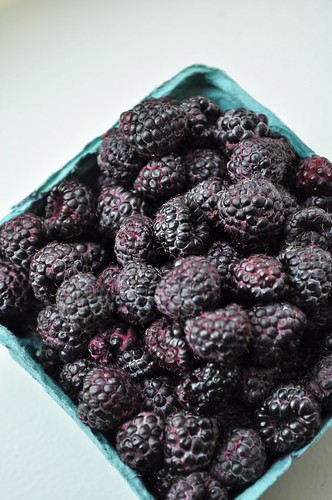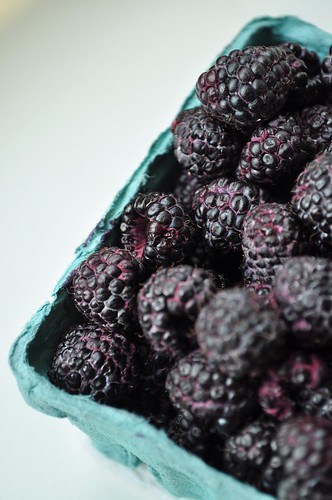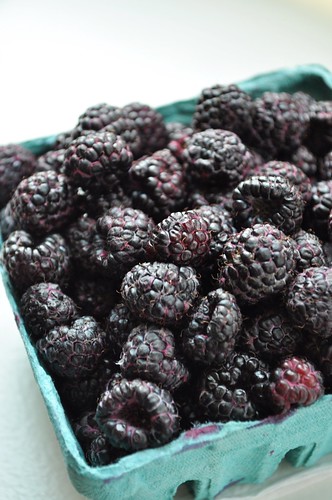Black Raspberry Jam
Growing up, I don’t think I ever once saw or knowingly ate a blackberry. In fact, I don’t think I really even knew what a blackberry looked like until last summer. This is not the fault of my parents or anything comparable to that tragic scene from Jamie Oliver’s Food Revolution. No, I just never knew what a blackberry was.
Because I thought it was something else.
When I was about 6 or 7 years old, before my family split and circumstance forced me to grow up much too quickly, my parents built a house together. This house today is referred to by my brother and myself as “the good house.” It sat on roughly two acres of land in a brand new development in the town where I spent three quarters of my non-adult life. My mom picked out chrome, leather-capped barstools for the kitchen, the kind that were built into the floor and spun, like at a malt shop. My dad built retaining walls in the backyard from massive boulders, by hand, to flank the concrete patio outside the basement door. I got to pick out pink carpet and pink paint for the very first room I would call my own. And my little brother was just happy to be living next door to Matt, a boy whose family had moved with ours from our previous neighborhood and had a Sega.
We were all in that house. It was a good house.
At the end of our property was a small farm field, no more than an acre deep, that stretched from our yard, down the next three, and to the road. Soybeans grew in that field. I remember wondering back then why in the world anyone would grow soybeans. What could you use them for anyway? Soy sauce?
My best friend at the time, Leah, and I used to run through that field, kicking up our legs and swinging them over the rows. We didn’t care about the beans, we wanted to get to the stretch of woods that ran between that field and the farmer’s other field, in which he grew corn. From there, those woods stretched up and over and back and everywhere—all the way to Leah’s house.
We would spend days wandering through the trees, making up games and stories, pretending to be explorers. Occasionally we’d disturb a baby deer lying hidden in the tall grass. It would spring up suddenly and bound away, frightening and exciting us at the same time. Sometimes we’d stumble upon old, broken down farm equipment, forgotten and rusting away. There was always something new to uncover, always something to return for.
One day we came across some bushes. The bushes were low and tangled and thorny. Amid their tangles and thorns were what looked to be unripe berries, hard little green and white nodules with just the faintest hint of red. Looking further along the bush, I spotted one, then two, then dozens of bright red orbs, glowing with sunlight. Twisted in among the red berries were branches bearing a dark, purple-black version.
“They look like raspberries. And blackberries! Is that what they are?”
Coddling a few in our hands, we ran them back to show our parents. We were at an age where the thought of fruit growing wild was almost fantastical and were rightfully cautious of eating anything we found. It was confirmed, though. Raspberries. Blackberries.
We spent many days during those summers returning to that patch and discovering at least half a dozen more. I filled my mom’s yellow, plastic colander once with dark, juicy berries. Leah’s older sister, who would babysit for us occasionally, worked with us to stuff them into a pie. When it emerged from the oven, the crust was pasty and almost completely raw, but it didn’t matter. It was all about the blackberries.
At least I thought they were blackberries.
Last summer, I took up canning. Paging through my canning book, I came upon a recipe for blackberry jam. Thinking back to those sweet little beaded caps that I used to pick as a child, I decided it needed to go on my list.
When I arrived at the greenmarket to snatch up some blackberries for my jam, I was sorely disappointed to find that the berries being sold there that day looked nothing like the ones I remembered. They were large, oblong clusters of fat, dark rounds with an odd white bit tucked inside. I bought some anyway, thinking, Maybe blackberries just look different on the east coast?
When I got home, I did some research. What I had purchased was indeed a blackberry. What I knew from my childhood were black raspberries. I instantly longed for that colander full of berries, and, through the rest of that summer, I wasn’t able to find a single one at the market.
This past week, my neighborhood farmer’s market opened. It’s just one day a week and consisted of only four stands this time, but it’s steps from my front door. I was going to pick up some blueberries for a batch of gluten-free blueberry crumb bars. When I arrived, there, next to the pints and pints of blueberries, among the sunlit red currants, were three small containers of black raspberries. I hesitated for a moment, feeling a twinge selfishness, before grabbing up all three. When I got home, I tasted one. Yes, there it was—that sweet, winey flavor, with a whisper of rosemary, tasting like the cool air of shadows beneath trees. I ate a few more, delighting in each one, refusing to take a single note for granted. I wanted to savor them. I wanted to save them.
So I made jam.
My first batch of jam this year wasn’t about preserving anything now, in this moment. It was all about preserving a memory from long ago. If I were to return to the good house, the berry patches that I used to scratch my shins and stain my fingers on would be gone. The woods that I used to roam through nearly every summer day would be gone as well. It’s all been cut down and developed into one congruous expanse of upper middle class homes and yards.
But when I taste that jam, I’m there again, huddled beneath an umbrella of leaves, the gold-yellow sunlight raining through, plucking soft little “blackberries” from their brambles. It’s summer, I haven’t a care in the world—maybe I’ll fill my colander and make myself a raw-crusted pie.






